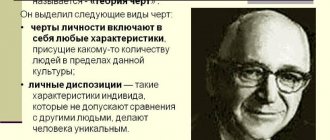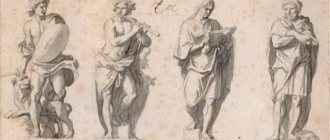Many people quite often compare a person's character with his temperament. Often even they are considered identical to each other. However, if we turn to scientific views, we can see that there are several points of view regarding the interaction of character and temperament: some scientists identify them (A. Ruzhitsky, E. Kretschmer), others contrast them and focus on the rivalry between them (V. Virenius, P. Viktorov), others consider temperament to be a component of character (S. Gorodetsky, S. Rubinstein), the latter are confident that temperament is the natural basis of character (B. Ananyev, L. Vygotsky).
What is temperament
It’s worth starting with a definition, to immediately clarify. Temperament is a number of psychological properties and behavioral characteristics of a person that he is endowed with from birth. Temperament cannot be influenced. Over time, people learn to control negative manifestations, but no one has yet succeeded in eradicating shortcomings, for example, an explosive, hot-tempered temperament. The nervous system influences brain impulses and provokes human actions.
A person inherits a set of psychophysical properties from the first seconds of life. He is unable to influence this process. Evaluative epithets do not apply to temperament. It determines the behavioral characteristics of the individual. The definitions of “good” or “bad” do not apply to him.
Differences between temperament and character
Character, unlike temperament, is formed over the course of a person’s life. The development of character is influenced by a number of specific factors:
- Education (parents and teachers play a big role in shaping a person’s character).
- Education (study, the pursuit of knowledge develops perseverance, patience, and result-orientation).
- Social life (the chosen communication environment shapes the attitude towards society).
- Financial situation (teaches you to react steadfastly to downfalls, not to lose your humanity during ups).
There are minor factors that can change a person’s character throughout life. Experienced acute crisis in family relationships, loss of a loved one or betrayal. Character can change dramatically. You often hear the phrase: “You’ve changed, you weren’t like that before...”. Indeed, a strong shock can turn a person’s consciousness upside down and completely change him.
This is unacceptable in relation to the subconscious. It is impossible to change temperament. A bright, charismatic person cannot withdraw into himself and become a hermit. Genes cannot be destroyed, but it is at the gene level that temperament is formed.
Character is behavior shaped by environmental attitudes. Temperament is the unchangeable qualities of the psyche that accompany a person throughout life. They influence character.
Definition of the concept
Temperament is a set of stable properties of the nervous system that determine the speed and strength of the reaction to external stimuli. In simple words, these are the basic settings of the individual’s psyche. Temperament has a significant impact on human activity and behavior.
This is an innate characteristic that does not change throughout life. If you were born, for example, melancholic, then you will remain so forever. Temperament manifests itself in men and women, in children and adults, in people with different cultural backgrounds and social levels.
Temperament should not be identified with a person’s character. There are specific differences between them, which we will discuss below.
The classification is based on the following properties of the nervous system:
- Emotional excitability. How quickly a person develops an emotional reaction in response to a stimulus.
- Introversion/extroversion. Where is the main attention directed: to the inner world or to the outer world.
- Rate of reactions. How quickly mental processes occur.
- Rigidity/flexibility. Ability to adapt to changing conditions.
- Reactivity. The severity of involuntary reactions to internal and external stimuli.
- Activity. The intensity of human influence on objects of the external world.
- Sensitivity. The minimum threshold of exposure that can cause a mental reaction.
More than 100 cool lessons, tests and exercises for brain development
Start developing
What are the types?
If character types are quite difficult to identify, then with temperament everything is much simpler. Psychologists have identified 4 main types. Of course, each person is unique; there is no 100% owner of a single classification. Often, a person is endowed with mixed types, where one predominates over the other. The dominant one determines the identity of the individual.
Sanguine
Sanguine. Lightness, ease in everything. A representative of this type is optimistic about the future and takes on a new business without thinking about failures. It’s a pity that with the same ease he abandons his plans and goals, he can switch gears and get carried away by something new. Such people are characterized as irresponsible and fickle. In fact, a sanguine person can be influenced by stirring up interest in what is happening. Then he will bring everything to the end.
Choleric
The most explosive temperament is choleric. He has attacks of aggression. Imbalance and passion often get in the way of making sound decisions. Cholerics are quick-tempered, often not ready for constructive dialogue and criticism. They are overly emotional and gesticulate a lot in conversation to attract attention. Mood swings often occur, from cheerful to depressive.
Melancholic
A melancholic person is radically different from a choleric person. People of this type are reserved, unsociable, and avoid noisy companies and new acquaintances. They analyze for a long time, experience failures, and have low self-esteem. Anxious. The smallest trouble knocks them out of their working rut for a long time.
Phlegmatic person
The main characteristics of a phlegmatic temperament: constancy, endurance, loyalty to principles. Phlegmatic people are prone to laziness and may not show interest in others, while being in a great mood. Do not try to unbalance him - attempts will be in vain. Phlegmatic people are constant, faithful to their ideals to the end.
Typology
Temperament is much easier to divide into types than character. They are well known: choleric, sanguine, phlegmatic and melancholic. Although most people have a mixed temperament type, let's look at them individually.
Choleric is the most unbalanced type. It can be compared to a lighter - click - it lights up. This type of character helps in emergency situations when quick decision-making or reaction speed is important.
Sanguine - ease of communication, friendliness, speed of reaction. Rarely goes to extremes. If interested, he is efficient; if the work does not inspire, he tends to be lazy.
A melancholic person is often a person with increased anxiety, but has depth and thoughtfulness. Impressive.
Phlegmatic people are the calmest people. Outwardly, they are most often calm and not prone to showing emotions. Slowly, but diligently.
You can determine what type of temperament a person belongs to by observing his behavior. In addition, there are a huge number of tests to determine the type of temperament.
It is very difficult to divide characters into certain subtypes. Many scientists and psychologists have tried to do this. As a result, several character divisions were formed. Character is divided into types as follows: strong-willed, emotional, rational. This division is related to temperament.
Character is also classified according to a set of certain traits:
- in relation to a person’s attitude towards people around him (rudeness, responsiveness, callousness, etc.);
- attitude to activity (laziness, activity, conscientiousness);
- attitude towards things (stinginess, frugality, accuracy);
- attitude towards the inner “I” (pride, selfishness).
We are not talking about temperament, whether it is good or bad; there can be no assessment here. But we often evaluate character traits. For example, when certain traits are combined, they say about a person: “Complex character” or “easy character.”
- Temperament is innate, character is acquired.
- Temperament cannot be changed, you can learn to restrain it, but character can be adjusted under the influence of external factors.
- Temperament is divided into generally accepted types, but many scientists tried to classify character, but did not come to a consensus.
- Temperament cannot be assessed; we evaluate character traits.
Temperament is a characteristic of an individual in terms of the dynamic characteristics of his mental activity, i.e. tempo, speed, rhythm, intensity of the mental processes that make up this activity. (V.D. Nebylitsyn)
There are three areas of manifestation of temperament:
- general activity (intensity and volume of interaction with the environment, the individual’s tendency to self-expression, transformation of reality);
- features of the motor sphere (speed, pace, rhythm, total number of movements);
- emotionality is divided into:
- impressionability - the subject’s affective susceptibility, his sensitivity to emotional influences;
- impulsiveness - the speed with which emotion becomes the motivating force of actions and actions without prior thought and a conscious decision to carry them out;
- emotional lability is the speed with which a given emotional state ceases or one experience changes to another.
What does temperament depend on?
We have sorted out the factors that influence a person’s character. But what about the influence on temperament? Of course, it is impossible to influence the body at the genetic level and convince the subconscious. Temperament cannot be touched or changed on your own or by working with psychologists. It has certain features.
Temperament is influenced by:
- Age factors. Over time, a person's reaction slows down. Even the brightest temperament of a choleric person can fade against this background. Young people, even while working on themselves, cannot pacify it. Nature has provided for everything. There is no need to rush time. Enjoy being active when you're young. The turn of a comfortable and calm old age will come in due time.
- Climate, territorial location. For example, the bright, explosive temperament of charismatic Italians has long been known throughout the world, while the inhabitants of the north are calmer and more reasonable. Of course, one cannot generalize. But the fact remains a fact.
Life standards and priorities have a strong influence on temperament. People prone to alcohol and poor diet find it difficult to control themselves. They often become depressed and aggressive. Often lonely in society. The situation will change only if life priorities are set correctly.
Properties of character and temperament
Based on the above, we note that temperament influences character traits. Of course, a person’s character is formed independently, but the degree of manifestation of certain qualities determines temperament. Let's say 4 different people have the same character trait - hard work.
Now we will analyze in detail the attitude towards work of employees with different types of temperaments:
- The choleric person will passionately immerse himself in the process, but will be aggressive at the first failures, blame others for everything and, most likely, will not complete the job if the problem is not resolved as soon as possible. Moreover, the choleric person does not intend to participate in solving the problem. He is committed to the final result. Interference knocks him out of his working rut.
- A sanguine person will enthusiastically embrace a new project; failures will not affect his mood. He will easily survive and forget them. Most likely, he will give preference to something new.
- A suspicious melancholic person will worry around the clock about non-existent problems and invent potential failures. He works hard, but due to his own insecurity, he is rarely satisfied with the result of his own efforts.
- A phlegmatic person will immediately focus on a new task. Outwardly, he will seem uninterested, but this is absolutely not the case. In his head he had already begun to work out a plan for implementing the assigned tasks. He doesn’t need haste, cold calculation and balance are his main helpers on the path to a better result.
Therefore, sensitivity is provoked by temperament, and character is formed only by the perception of external factors.
Character and temperament are not necessarily closely related. The same character trait of a person is interpreted and perceived by others differently, depending on temperament.
It is fair to note that temperaments of the same type do not occur in nature; they are mostly mixed and predominate to a greater or lesser extent.
Basic provisions
Based on the relationship between the two main concepts of personality psychology, scientists have identified blocks in the character structure that can be briefly described as follows:
- An emotional block characteristic of melancholic and sanguine people. It includes empathy, impulsiveness, and emotional sensitivity.
- A volitional block, pronounced in choleric people. It is based on integrity, categorical judgments, and responsibility.
- An intellectual block characteristic of phlegmatic people. It includes a penchant for analysis and reasoning, thoughtfulness, intelligence, cognitive interest, and the ability to understand the figurative meaning of statements.
How to change yourself and your character for the better
In addition, character and temperament are reunited in the overall orientation of the individual. This is noticeable in a person’s attitude towards himself and others, towards his own and other people’s work, towards works of art. Personal orientation consists of goals and prevailing motives.
Important! The active formation of the basic foundations of character occurs in the period from 2 to 10 years. It is at this time that the child needs to see a positive example in an adult and adopt positive traits from him. Communication is of great importance for the development of character. There will be a huge difference between the character of a child whose family practiced respectful and trusting communication between members, and the character of a child in an orphanage.
During the preschool period, the main role model for a child is his parents. From the moment they enter school, in addition to parents, teachers and classmates influence the formation of children's character. During adulthood, the character of a man or woman is influenced by colleagues and superiors.
Additional Information. It is a common belief that the formation of character is completed in youth, but some of its traits are acquired only in adulthood.
Traits of female and male temperament
Does gender affect temperament? Definitely yes! Women are more emotional and prone to depression. Men are naturally endowed with strong-willed and leadership qualities. But this does not mean that a woman cannot take on a leading position in a team.
Men's thinking is straightforward and results-oriented. The woman is careful and prudent, but at the same time has poor control over emotions. Everything is formed at the genetic level. The instinct of self-preservation of women is more developed than that of men, since the main purpose of a woman is to bear and give birth to a child.
You might think that all men are choleric and sanguine, and women are melancholic and phlegmatic. Not at all. The thing is that a choleric woman and a man show temperament differently. Let’s say that in a dispute between two choleric people of different sexes, a woman will show herself more emotionally and aggressively, while a man will remain restrained. Surprisingly, this is true.
Is it possible to change temperament
I think the phrase “Nothing is impossible in the world” is inappropriate here. A person’s temperament, unlike character, cannot be changed. It is impossible to influence the moment of its acquisition. It is transmitted at the genetic level from parents and ancestors. The only thing we are capable of is to control ourselves in not the best manifestations of our temperament and character. Contain aggression and irritability, do not become despondent and do not offend near and dear people in a fit of impulsive passion.
Not everyone manages to overcome their emotions, but those few who have mastered themselves are happy and enjoy the benefits of temperament. An emotional and incendiary choleric person is able to attract the attention of the crowd and lead them with him. The enthusiasm of a sanguine person is infectious. Those around him feel comfortable and happy in his company. The compassion and sincerity of a melancholic person is captivating. And the sanguine person, despite everything, moves forward and achieves his goals. Skilfully use the character and temperament that nature has endowed you with. Conquer the heights of success.
Article:
The term “temperament” was coined by Hippocrates.
Translated from Latin (temperamentum), this word means a person’s excitability and susceptibility to external stimuli. V.S. Merlin believed that the individual properties of the psyche, including the properties of temperament, are determined by the individual properties of the nervous system, and those, in turn, depend on the properties of the organism as a whole. Therefore, the properties of temperament play a regulatory role in mental activity. The dynamics of all mental processes should depend on them. This function is performed by the individual characteristics of emotions and will. Intelligence also plays a significant role in the regulation of mental activity. All the cognitive processes we have described - excitability, concentration, stability of attention, speed of reproduction, speed and flexibility of associative processes affect the dynamics of mental activity, and therefore temperament. Academician I.P. Pavlov, in his theory about the typological properties of the nervous system, gave an interpretation of the nature of temperament. He revealed the basic properties of nervous processes. The scientist included the following: 1) the strength of excitation and inhibition; 2) balance or imbalance of these processes; 3) mobility of processes. Based on the study of these properties I.P. Pavlov identified the types of the nervous system and correlated them with a certain type of temperament.
1. The weak type is characterized by weakness of nervous processes and rapid fatigue. This type corresponds to the melancholic temperament. Children with this temperament tend to be slow, unsociable and withdrawn. It is difficult for them to adapt to new conditions, and they are sad from separation from their old place, or from old friends, or from their grandmother. For such children, transferring to another class, another school is very painful. Such a child needs much more time to prepare lessons, and if he does not succeed, he becomes insecure and timid.
2. The strong, balanced, sedentary type is characterized by slow inclusion in activities and slow switching from one type of activity to another. This type of activity correlates with a phlegmatic temperament. Phlegmatic children, despite their slowness, have increased performance. As a rule, this is a closed type. The child does not reveal his experiences, but they, of course, exist and can be associated, first of all, with his slow speech and movements. Although it should be noted that if you entrust something to such children, you can rest assured that they will definitely complete the assigned task. And patience and slowness, which characterize this type of temperament, will help them in this.
3. The strong, balanced, mobile type is characterized by great performance, the inclusion of the child in various types of activities and quick switching from one type to another. This type correlates with the sanguine temperament. Children with this temperament have well-functioning motor and verbal activity. They tend to have very expressive faces. They are sociable, easily get along with other children and easily adapt to changed conditions.
4. The strong, unbalanced type is characterized, like the previous one, by high performance, but the process of excitation prevails over the process of inhibition. This type corresponds to the choleric temperament. A child with a predominant choleric temperament usually does not restrain his emotions. He is easily excitable, mobile, explosive and hot-tempered. He has extremely developed facial expressions.
Such a child eagerly takes on various tasks, but his emotions go through the roof, and he may not be able to cope with the task solely because of his excitability.
The presented characteristics of temperament do not indicate that they are clearly manifested in every child. Practice shows that every person has a piece of each type of temperament. But the ratio of these particles is individual and depends on many personality traits. Temperament itself does not determine either the abilities or interests of the child, but it largely determines the style of mental activity and style of behavior. This means that it needs development and pedagogical support from an adult.
In this vein, we want to suggest the actions of an adult with a child, taking into account the type of his temperament.
Choleric temperament
When working with such children, an adult must understand that the process of excitation in them prevails over the process of inhibition. The child is overly active, emotional, impetuous. It requires careful, calm handling. The main task of the teacher is to teach him self-control, that is, to be able to manage the manifestations of his temperament. When using reward or punishment, you must remember that the reaction can be unpredictable. When working with such a child, giving him instructions, it is important to ensure that the instructions are calmer and cannot cause a storm of emotions in the child, especially since in a choleric person any assignment evokes an emotional response. In a younger schoolchild with a pronounced choleric temperament, it is possible to develop qualities necessary for life in society, such as social activity, enterprise, passion for something useful to society, comradely mutual assistance and collectivism.
Sanguine temperament
I.P. Pavlov called this type of temperament ideal. A child with a pronounced sanguine temperament is distinguished by high performance. Therefore, when working with a group of children, the teacher can fully rely on such a student. Moreover, a child with this type of temperament is usually responsible and can be entrusted with any task. He will perform it cheerfully and without ostentatious bravado. There is a danger of overpraising such a child and instead of the cheerfulness, responsiveness, hard work and sensitivity that we expect, we may get frivolity, instability of interests and attachments, excessive attention to our successes and indifference to other people.
Phlegmatic temperament
A phlegmatic person is just as efficient as a sanguine person. But, unlike him, he slowly gets involved in activities. Therefore, when communicating with such children, it is necessary to provide for deadlines for completing one or another assignment. Deadlines discipline the phlegmatic person and help him correctly distribute time and energy to complete the assigned work. The phlegmatic person is reliable and is characterized by conscientiousness in carrying out assigned work.
The teacher needs to help such a child cope with slowness. Although there is nothing extraordinary about her, the attitude of other children, lively children, choleric children, can ruin the joy of being in a group for a phlegmatic child.
Melancholic temperament
Usually this is a very vulnerable child. His slowness, unlike a phlegmatic person, has a slightly different property. He experiences his failures very painfully, but at the same time sympathizes with the failures of other children.
In working with such a student, the teacher can use, in the good sense of the word, the highly developed conscience of a melancholic student. Such a child needs constant support from others. It takes him more time to prepare, for example, homework, than other children. But under no circumstances should the teacher focus on this in class. On the contrary, an experienced teacher is results-oriented. And the result of a melancholic student is usually no lower than that of children with other types of temperament.
There is no need to rush such a child when he answers. It must be remembered that this is not choleric. In him, the processes of inhibition are more developed than the processes of excitation. You can calmly wait for his answer, filling the pause with some comments on the essence of the question, without focusing on the slowness in the answer.
Temperament is closely related to character. Every person is different from another. There are no identical individuals in the world. Each person has an individual psychological identity. In this case, they talk about the traits inherent in this particular person, that is, characteristic of him. They are quite stable, arise in certain situations and characterize a specific individual. The word “character” is of Greek origin (character). It is defined as a set of mental characteristics of a given person, manifested in his actions and behavior. Character traits manifest themselves in various areas of a person’s life. They largely determine what place a person will take in the social matrix. Each character trait manifests itself in certain typical circumstances. That is why character is closely related to the child’s attitude towards the world around him. Character traits have a motivating force, which is undoubtedly an individual characteristic of a person. Under the same conditions, some people act this way and others act differently. Thanks to such inclinations, people in extreme, stressful situations can make decisions that contradict objective conditions, but provide the opportunity to survive precisely because of the decision made. Although, in fairness, it should be noted that the person demonstrates great persistence and energy in his characteristic way of acting. Character is a system consisting of interconnected components. Individual character traits depend on each other. In psychology, four character traits can be distinguished, determined by different attitudes of the individual:
1. Properties that express the attitude of the individual to the team as a whole and its individual members. Such properties include responsiveness, demandingness, kindness, arrogance, etc.
2. Properties that express an attitude towards work (hard work, responsibility, conscientiousness, etc.).
3. Properties that express the attitude towards the things around a person (neatness, sloppiness, sloppiness, cleanliness, etc.).
4. Properties that express the attitude towards oneself (ambition, pride, humiliation, modesty, immodesty, etc.).
Let's try to try on these properties for a six- to seven-year-old child.
Speaking about the attitude towards the collective as a character trait, it is necessary to remember that the child is still poorly oriented towards the collective. Rather, what is more important to him is his teacher's acceptance. With a reasonable organization of collective life, the teacher shapes the child’s character traits through a system of instructions and the child’s participation in various activities. It is in such forms that a value-based attitude towards the collective is formed, a stable awareness of oneself is developed as part of the collective of the class, school, and subsequently society.
Labor in the system of relations of mutual assistance and cooperation plays a vital role, shaping the basic moral properties of the child. Basically, self-care work predominates in preschool and primary school age. But understanding that this is only the first stage, the teacher must be able to predict the work activity and results of the child’s work. It is in work that a sense of responsibility, duty, endurance, initiative, self-control, etc. is formed. And we need to start with the basics - teach a child to work for the benefit of peers, parents, teachers. Show him the value of his hard work. Of course, any work is important, be it cleaning the classroom or preparing for New Year's Eve, or a labor lesson. The result obtained during the labor effort must be real and bring benefit to others and satisfaction to the child. This is the moral characteristic of work. “I rejoice, and my labor joins the labor of my republic...” the poet proclaimed. And the famous teacher A.S. Makarenko wrote that “Labor has not only social and production significance, but is also of great importance in personal life. We know well how much more fun and happy people live when everything goes well and argues, who will not get lost under any circumstances, who know how to own and command things. And vice versa, those people who always cause pity are those who become stumped before every trifle, who do not know how to take care of themselves, who always need nannies, then a friendly service, or help, and if no one helps them, they live in an uncomfortable environment , sloppy, dirty, confused.”
Properties such as neatness, cleanliness, and sloppiness are largely determined by the conditions of family upbringing. A child comes to school with a ready-made set of similar properties. And, if these traits are not clearly expressed or have a negative connotation, most likely the teacher or educator will face the problem of re-educating them. Of course, the formation of such properties is greatly influenced by natural conditions. Therefore, when working with children in this direction, it is necessary to take into account their individually expressed natural and social (read family) character traits.
The fourth group of character traits, namely the attitude towards oneself, seems to us the most fragile, since it is associated with deeply personal, intimate aspects of character - love or dislike for oneself. The child is extremely sensitive to the acceptance or rejection of his personality by surrounding peers and adults. This sensitivity has individual differences both in strength of expression and direction. Preschoolers and primary schoolchildren, for example, due to age characteristics - imitation, level of expression of the emotional sphere - are quite easily influenced by an adult. It is important to find the right tone in working with such children. If a child has low self-esteem, the teacher uses a specially selected system of methods to increase it. The child trusts the adult, and it is not difficult to convince him that he is not as bad as he was told, that he simply did not have the opportunity to show his potentially good character traits. If, on the contrary, the child is vain, he has high self-esteem, then the teacher, educator, with the help of a different system of pedagogical methods and means, will show that he is not as good as he thinks about himself. The main thing in this work is moderation, trust and a sincere attitude towards the child. If we have a teenager in front of us, then upbringing is complicated by the teenager’s desire for “adulthood” and the rejection of any criticism, even fair ones.
Building character is hard work. An adult needs to imagine a certain ideal to which he strives in his work with children. A.G. Kovalev offers his own structure of a positive nature. Positive character can be manifested in the following synthetic traits.
1. Morality of character. Here, the complete correspondence of a person’s deeds and actions with her moral convictions is manifested. This is an honest person, conscientious, able to work and rejoicing in the results of his work. He is friendly and attentive to people, modest in his attitude towards himself. Such children, as a rule, are loved by both adults and peers. True, their beliefs are at the stage of formation, but if conditions do not change for the worse, their moral character will continue to manifest themselves in the future.
2. Integrity of character is the consistency of all its manifestations, the correspondence of deeds to words, consistency of behavior. This person is open to others. He himself and the people around him know what he will do in certain situations. What we know about such children is that their behavior is predictable. At their core, they are leaders in a team. They are teacher assistants in academic and extracurricular activities.
3. Strength of character is the energy with which a person realizes his goals. Such a person is capable of being passionate and overcoming difficulties. Strength of character is also manifested in the firmness with which a person defends his convictions. As a rule, there are such children in every class. They are extremely sincere and firm in their preferences and statements. Of course, in middle and older age this firmness may be maximalism, or it may also be a character trait.
4. Flexibility of character. This is a person who takes into account the conditions in which he finds himself. He is able to change behavior according to the demands of the situation. He is able to correct his character if this is required by society or his environment. This is the absence of “hard-headedness.” A child’s understanding of what is true is not always the truth for others. This character trait should not be confused with a kind of “plasticity”, when a child completely falls under the influence of others, the personality is leveled and ceases to be integral and self-sufficient. Flexibility denotes the wisdom of the child, the right choice of the path, even if this path is a temporary retreat.
5. Balance of character. This is the ratio of restraint and activity, the most optimal in activity and communication with people. Even among adults with extensive life experience and a developed function of analysis and synthesis, balance is not so common. Due to the development of the emotional sphere, preschoolers and primary schoolchildren are, as a rule, poorly balanced. But they just haven't fully learned it yet. With the development of the volitional sphere will come the ability to correlate activity and restraint in communicating with people.
I would like to hope that readers are convinced that every child is unique. Everything, absolutely everything influences its formation. There are no absolutely identical people on earth.










